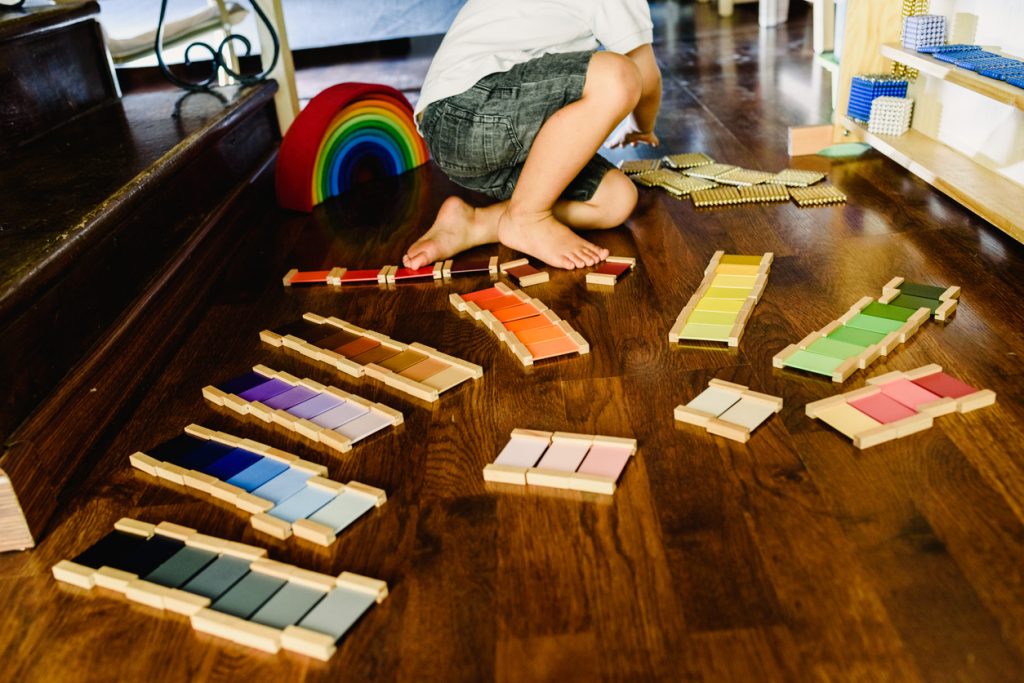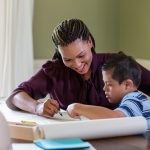Montessori Education: The Nine Senses
One of the main components of the Montessori pedagogy is using all of the senses in an educational environment. By creating an environment in which children learn using more than one sense, they are able to remain engaged and retain their learning.
This is why there is such a large emphasis on having children interact with their environment in the classroom and outside.
In The Absorbent Mind, Maria Montessori wrote:
“The senses, being explorers of the world, open the way to knowledge. Our apparatus for educating the senses offers the child a key to guide his explorations of the world…”
Below are the nine senses and why they are important in the development of the child.
Visual Discrimination

Visual discrimination teaches children to differentiate between forms, colours, and sizes. It helps them tell things apart. Learning to differentiate helps children to categorize and is taught through objects that can be “sorted” or interacted with in different ways.
Tactile
Touch is a huge part of the Montessori environment because it’s a huge part of a child’s cognitive development! Have you noticed that toddlers and other young children want to touch everything in sight? This need to touch is a perfectly normal part of their development.
In our classrooms, we have a variety of tactile options available for children to interact with. We encourage them to communicate what the object feels like: soft, scratchy, smooth, bumpy, etc.
Stereognostic
Stereognostic is a sense (sometimes called tactile gnosis) that requires a person to identify an object without looking, smelling, tasting, or hearing it. An example of stereognostic sense would be finding your alarm clock in a dark room without being able to see it.
By removing sight, smell, taste, and sound from a child’s repertoire, it strengthens other senses, especially touch. We often do this in the classroom by placing an object in a cloth bag and then asking the child to feel it with their hands to determine what it is.
Baric
Similar to touching an object, baric learning — typically taught through the baric tablets — helps children tell the difference in weight between one object and another. Using weighted objects that vary in size, shape, and colour encourages children to focus on the weight of the objects.
Thermal
Teaching children about the difference in temperature doesn’t just teach them about the world around them, it teaches them about safety as well.
One of the most practical ways to teach a child about temperature is with the changing of seasons, given that the temperature will determine how they dress for the day. This is why you’ll often find thermometers in a Montessori classroom.
Olfactory
Your olfactory system is your sense of smell. Children can develop their sense of smell by sorting and matching objects based on the strength of the smell. We teach the vocabulary associated with the smells, as well as how to compare between strong and faint smells. This is often performed by smelling bottles.
At home, you can incorporate olfaction into everyday activities like cooking and gardening!
Gustatory
Much like olfactory learning, gustatory learning (sense of taste) develops the taste buds with trying, testing, and sorting various tastes. Mealtimes can become learning experiences and can help your children develop wide-ranging palettes and a varied diet.
Chromatic

A Montessori education teaches children how to differentiate between colours and between variations in colour. Often, we use an activity called ‘the colour tablets’ to demonstrate these subtle, but important, changes.
Proprioception
Proprioception, otherwise known as spatial awareness, help’s a child develop their unconscious perception of movement and orientation. An example of proprioception would be our ability to close our eyes and touch our left index finger to our right eyebrow. The development of proprioception is an integral part of a child’s gross motor skills.
If you’d like to learn more about the nine senses or talk to our administration about enrolling your child into the Montessori School of Wellington, don’t hesitate to reach out to us.










